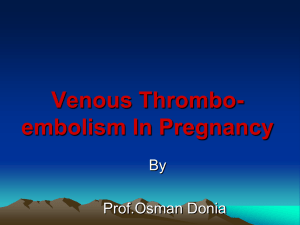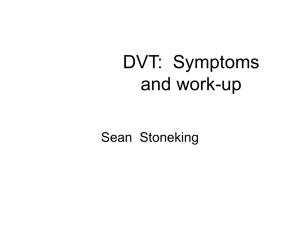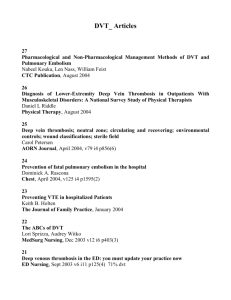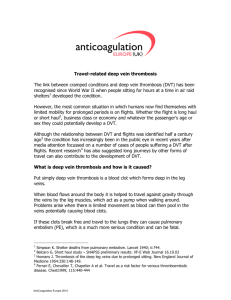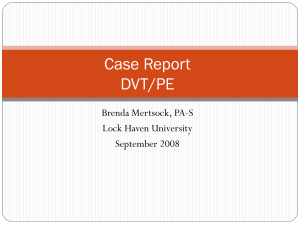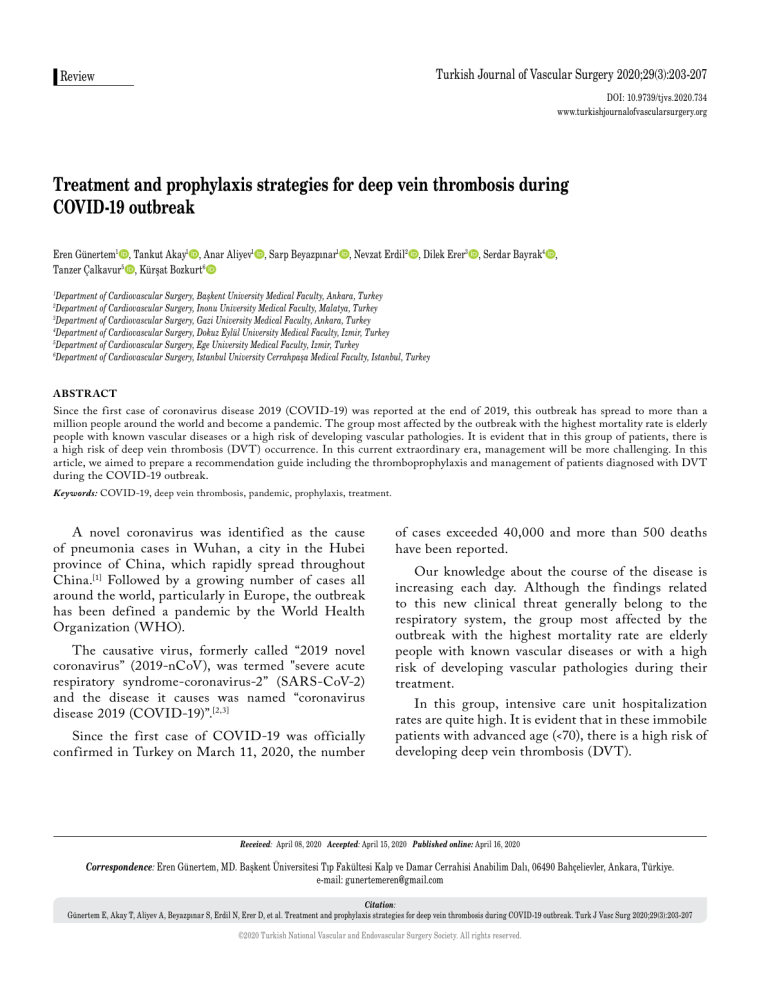
Turkish Journal of Vascular Surgery 2020;29(3):203-207
Review
DOI: 10.9739/tjvs.2020.734
www.turkishjournalofvascularsurgery.org
Treatment and prophylaxis strategies for deep vein thrombosis during
COVID-19 outbreak
Eren Günertem1, Tankut Akay1, Anar Aliyev1, Sarp Beyazpınar1, Nevzat Erdil2, Dilek Erer3, Serdar Bayrak4,
Tanzer Çalkavur5, Kürşat Bozkurt6
Department of Cardiovascular Surgery, Başkent University Medical Faculty, Ankara, Turkey
Department of Cardiovascular Surgery, Inonu University Medical Faculty, Malatya, Turkey
3
Department of Cardiovascular Surgery, Gazi University Medical Faculty, Ankara, Turkey
4
Department of Cardiovascular Surgery, Dokuz Eylül University Medical Faculty, Izmir, Turkey
5
Department of Cardiovascular Surgery, Ege University Medical Faculty, Izmir, Turkey
6
Department of Cardiovascular Surgery, Istanbul University Cerrahpaşa Medical Faculty, Istanbul, Turkey
1
2
ABSTRACT
Since the first case of coronavirus disease 2019 (COVID-19) was reported at the end of 2019, this outbreak has spread to more than a
million people around the world and become a pandemic. The group most affected by the outbreak with the highest mortality rate is elderly
people with known vascular diseases or a high risk of developing vascular pathologies. It is evident that in this group of patients, there is
a high risk of deep vein thrombosis (DVT) occurrence. In this current extraordinary era, management will be more challenging. In this
article, we aimed to prepare a recommendation guide including the thromboprophylaxis and management of patients diagnosed with DVT
during the COVID-19 outbreak.
Keywords: COVID-19, deep vein thrombosis, pandemic, prophylaxis, treatment.
A novel coronavirus was identified as the cause
of pneumonia cases in Wuhan, a city in the Hubei
province of China, which rapidly spread throughout
China.[1] Followed by a growing number of cases all
around the world, particularly in Europe, the outbreak
has been defined a pandemic by the World Health
Organization (WHO).
The causative virus, formerly called “2019 novel
coronavirus” (2019-nCoV), was termed "severe acute
respiratory syndrome-coronavirus-2” (SARS-CoV-2)
and the disease it causes was named “coronavirus
disease 2019 (COVID-19)”.[2,3]
Since the first case of COVID-19 was officially
confirmed in Turkey on March 11, 2020, the number
of cases exceeded 40,000 and more than 500 deaths
have been reported.
Our knowledge about the course of the disease is
increasing each day. Although the findings related
to this new clinical threat generally belong to the
respiratory system, the group most affected by the
outbreak with the highest mortality rate are elderly
people with known vascular diseases or with a high
risk of developing vascular pathologies during their
treatment.
In this group, intensive care unit hospitalization
rates are quite high. It is evident that in these immobile
patients with advanced age (<70), there is a high risk of
developing deep vein thrombosis (DVT).
Received: April 08, 2020 Accepted: April 15, 2020 Published online: April 16, 2020
Correspondence: Eren Günertem, MD. Başkent Üniversitesi Tıp Fakültesi Kalp ve Damar Cerrahisi Anabilim Dalı, 06490 Bahçelievler, Ankara, Türkiye.
e-mail: gunertemeren@gmail.com
Citation:
Günertem E, Akay T, Aliyev A, Beyazpınar S, Erdil N, Erer D, et al. Treatment and prophylaxis strategies for deep vein thrombosis during COVID-19 outbreak. Turk J Vasc Surg 2020;29(3):203-207
©2020 Turkish National Vascular and Endovascular Surgery Society. All rights reserved.
Turk J Vasc Surg
204
If a COVID-19 patient, who is already undergoing
severe respiratory involvement, complicates with DVT
and pulmonary venous thromboembolism (VTE), the
clinical situation will worsen, the treatment periods
will be prolonged and become more challenging.
In order to prevent the spread of the disease,
individuals are being requested to “stay at home” in our
country like in the whole world. A majority of people
started self-isolations at home and try to work remotely
using laptops/smart phones. Therefore, it would not
be wrong to say that social isolation strategies will
likely reduce individuals’ physical activity, and lead
to decreased mobility. As it is known, immobility
is a significant risk factor for DVT development.
Considering this, we can predict that the incidence of
DVT may increase during the pandemic.
In this study, we aimed to prepare a
recommendation guide under different topics in light
of the current literature regarding DVT prophylaxis
and treatment approaches for the uninfected
population, follow-up of patients diagnosed with
DVT during the COVID-19 outbreak as well as the
preferences in interventional or medical treatments.
Prevention from Deep Vein
Thrombosis for Uninfected
People
In order to prevent the spread of the COVID-19
and not be affected by this disease, it is recommended
by the authorities that people around the world isolate
themselves at home. People are encouraged to work at
home on a “home-office” basis. This situation causes
a more sedentary life style. As it is known, immobility
is an important risk factor for DVT. Therefore, it
is possible to say that the incidence of DVT in the
population will increase during the pandemic. Taking
some measures is crucial for people in the risk group
(Table 1).[4]
Recommendation 1: Measures to be taken by
individuals staying at home: If possible, avoid being
immobile for long periods at home. Individuals
working from home should avoid sitting for long
hours and do several exercises for working the calf
muscle while sitting on the chair (i.e. while your
feet are on the ground, lift the heels up and take the
fingertip position). It is recommended to stand up and
walk for a while. Attention should be paid to intake
fluids sufficiently. People should not delay applying
to a healthcare institution in case of occurrence of any
symptoms that may be related to DVT.
Management of Uninfected
Individuals Under Follow-up
with Deep Vein Thrombosis
Lifetime incidence of deep vein thrombosis is
between 2.5% and 5%.[5] In the population, there is a
considerable number of patients under anticoagulant
therapy due to DVT. It is important to develop specific
treatment and follow-up algorithms for such patients.
We should prefer approaches that will keep these
individuals away from health institutions unless it is
necessary.
Recommendation 2: In order to prevent patients
from applying to health institutions for international
normalized rate control during the outbreak,
physicians should consider switching anticoagulant
therapy to low molecular weight heparin (LMWH)
or direct oral anticoagulants (DOACs). Routine
controls may be postponed to a date after the
outbreak except for patients in Table 2.
Management of Patients with
Acute Deep Vein Thrombosis
During the Outbreak Period
Incidence of VTE is around 104-183 per 100,000
people/year.[6] This can increase to 68/1,000 in highrisk cases.[7] Thus, it is observed that the frequency of
VTE has increased in recent years. This means that
during the outbreak, we are more likely to encounter
outpatients who are diagnosed with acute DVT every
day in healthcare facilities. In this group of patients,
we should be sensitive to perform the most appropriate
approach under the conditions of the current pandemic.
Although there has been no difference in the
acute distal DVT patients in recent studies, reduced
risk or severity of post-thrombotic syndrome has
been demonstrated with catheter-directed treatment
options in acute proximal (iliofemoral) DVT patients
during follow-ups.[8-10] For this reason, there is an
Table 1. Risk factors for deep vein thrombosis
•
•
•
•
•
•
•
•
•
•
•
Inheriting a blood-clotting disorder or personal/family history
Recent trauma or surgery
Pregnancy
Birth control pills (oral contraceptives) or hormone replacement therapy
Being overweight or obese
Smoking
Cancer
Heart failure
Inflammatory bowel disease such as Crohn’s disease or ulcerative colitis
Older age (>60)
Immobility
DVT management during COVID-19 outbreak
Table 2. Conditions requiring outpatients to apply to health
institutions
• Major bleeding related with anticoagulant therapy (gastrointestinal bleeding,
sudden neurologic disorders which can be related with central nervous system
bleeding, etc.)
• Pulmonary thromboembolism-related symptoms (shortening of breath,
sudden chest or back pain, etc.)
• Infectious findings in patients with venous ulcer (purulent discharge, local
tenderness, redness, and warmth in ulcer area)
• Development of symptoms that may be associated with acute deep vein
thrombosis in a different limb or diseased limb despite regular anticoagulant
usage (hospitalization for an interventional treatment option can be considered
in this situation)
increased tendency to adopt these treatment methods
in daily practice. However, for interventional treatment
methods, patients must be hospitalized for three to
five days.
During the outbreak, this can be considered as
unnecessary hospital bed occupancy; however, it
also places patients under the risk of COVID-19.
Moreover, according to the results of the Catheter
Versus Anticoagulation study announced in early
2020, interventional treatments did not yield superior
results compared to standard treatment.[11] In light of
these findings, we may assume that no consensus has
been established on this issue yet and the discussions
will continue for a while. Then, it would be appropriate
to prefer standard anticoagulant treatment instead
of interventional treatment methods particularly for
individuals with COVID-19 risk factors during this
period.
Another important issue that challenges physicians
is deciding on the patients to be hospitalized. As
highlighted in the Peripheral Artery and Venous
Diseases National Treatment Guide published in
2016,[12] treatment at home is recommended as much
as possible for patients with acute DVT. Again, in
this guideline, it was emphasized that the patients
mentioned in Table 3 should be treated in hospital:
Considering that the vast majority of patients
cited in Table 3 is also at high risk for COVID-19, we
believe that the decision should be established by the
physician.
While conducting acute DVT treatment for in- or
outpatients, LMWHs or DOACs may be a rational
choice for the reasons we mentioned earlier in this
paper.
Recommendation 3: Outpatients diagnosed
with acute DVT during the outbreak should be
205
Table 3. Hospitalization indications for patients with acute deep vein
thrombosis
•
•
•
•
•
•
•
•
•
•
•
•
Patients with massive thrombosis
Patients at high risk of bleeding
Patients with active bleeding
Recent surgery history
Active peptic ulcer
Advanced liver disease (international normalized rate >1.3)
Thrombocytopenia (<100,000) or familial bleeding disease
Patients weighing less than 45 kg and more than 100 kg
Children
Pregnant females
Patients with other medical problems (dialysis requirement, etc.)
Venous gangrene
treated at home if possible in first place. Preference
of hospitalization should be left to the physician,
according to comorbidities and COVID-19 risk factors
of patient. Low molecular weight heparins or DOACs
may be the first choice for anticoagulant therapy.
Deep Vein Thrombosis Treatment
and Prophylaxis in Hospitalized
Patients With COVID-19
Hospitalized patients diagnosed with COVID-19
have a higher risk of developing DVT. Critically
ill patients fulfill two criteria of Virchow’s triad.
First of all, they have reduced venous f low due to
immobility. Moreover, immune reactions, which
can trigger prothrombotic changes and endothelial
damage, are likely according to recently reported
investigations about COVID-19.[13] In case of suddenonset hypoxia, respiratory distress or hypotension,
VTE should be considered. Development of VTE
may affect prognosis of COVID-19 patients with
severe respiratory failure negatively. For this reason,
it is crucial to conduct a risk analysis for DVT and
start thromboprophylaxis as soon as possible in
hospitalized patients with COVID-19. Management
will be more challenging in case of DVT occurrence
in hospitalized patients with COVID-19. In
patients with low risk for bleeding, such as in
those aged less than 65 years, and with absence
of cancer history and recent trauma or surgery,
pharmacomechanical catheter-directed thrombolysis
may be appropriate.[14] A case series conducted by
Matusov et al.[15] demonstrated that in a population
of critically ill patients, the bedside placement of
the inferior vena cava filter is feasible and safe. This
option should also be kept in mind by physicians for
preventing VTE. In brief, each patient should be
evaluated individually by the vascular team.
Turk J Vasc Surg
206
Drugs
Hydroxychloroquine
Azithromycin
Lopinavir/Ritonavir
Favipiravir
Remdesivir
Oseltamivir
Ribavirine
Heparin
Enoxaparin
Apixaban
Rivaroxaban
Edoxaban
Dabigatran
Warfarin
No interaction
High risk
Low risk
Do not use together
Figure 1. Drug interactions.
Recommendation 4: The risk of DVT
should be assessed in all COVID-19 patients.
Thromboprophylaxis should be given to all high-risk
patients according to the National Institute for Health
and Care Excellence guideline:[16]
-----
For creatinine clearance (CrCl) >30: Give
LMWH.
For CrCl <30 or acute kidney injury: Give
dose-reduced LMWH of unfractionated
heparin 500 units subcutaneously.
All immobilized patients would benefit from
intermittent pneumatic compression.
Mechanical thromboprophylaxis should be
used alone if platelets <30,000 or in the
presence of any bleeding.
Recommendation 5: Consider VTE in patients
with sudden-onset oxygen desaturation, respiratory
distress or hypotension.
Management of Coagulopathy
Associated with COVID-19
It has already been recognized that acute
inf lammatory
response
triggers
activation
of fibrinolysis. In a multicenter study including
191 COVID-19 patients, 3 sec prolongation of
prothrombin time or 5 sec extension of activated
partial thromboplastin time was present in 50% of
the non-survivors and 7% of the survivors. Moreover,
lower platelet counts were noted in 20% of the nonsurvivors and 1% of the survivors.[17] For this reason,
physicians should be careful while starting any
anticoagulant therapy in the presence of DVT.
Recommendation 6: While starting an
anticoagulant therapy, basic hemostatic system tests
should have been screened. Bleeding risk analysis can
be performed.
Recommendation 7: Abnormal coagulation test
results do not require correction in patients without
evident bleeding.
Anticoagulant Drug
Interactions in COVID-19 Patients
Scientists are endeavoring to find specific drug
options to control the virus. Several drugs such as
chloroquine, arbidol, remdesivir, and favipiravir are
currently undergoing clinical studies to test their
efficacy and safety in the treatment of COVID-19
and some promising results have been achieved thus
far.[18-21] When an anticoagulant treatment is needed,
physicians should be aware of the drug interactions
below (Figure 1).[22]
Recommendation 8: While starting an
anticoagulant therapy, potential drug interactions
should be taken into account.
In conclusion, according to the current knowledge,
we, as vascular surgeons, should develop certain
algorithms for preventing DVT and identify possible
treatment approaches to follow. While managing the
treatment process, we should also protect the society
and ourselves.
Declaration of conf licting interests
The authors declared no conf licts of interest with respect
to the authorship and/or publication of this article.
Funding
The authors received no financial support for the research
and/or authorship of this article.
DVT management during COVID-19 outbreak
REFERENCES
1. Wang D, Hu B, Hu C, Zhu F, Liu X, Zhang J, et al.
Clinical Characteristics of 138 Hospitalized Patients With
2019 Novel Coronavirus-Infected Pneumonia in Wuhan,
China. JAMA. 2020 Feb 7. [Epub ahead of print]
2. Zhou P, Yang XL, Wang XG, Hu B, Zhang L, Zhang
W, et al. A pneumonia outbreak associated with a new
coronavirus of probable bat origin. Nature 2020;579:270-3.
3. Naming the coronavirus disease (COVID-19) and the
virus that causes it [Internet]. [cited 2020 Mar 21].
Available at: https://www.who.int/emergencies/diseases/
novel-coronavirus-2019/technical-guidance/namingthe-coronavirus-disease-(covid-2019)-and-the-virusthatcauses-it. [Accessed: Mar 23, 2020].
4. Anderson FA Jr, Spencer FA. Risk factors for venous
thromboembolism. Circulation 2003;107:I9-16.
5. White RH. The epidemiology of venous thromboembolism.
Circulation 2003;107:I4-8.
6. Heit JA, Spencer FA, White RH. The epidemiology
of venous thromboembolism. J Thromb Thrombolysis
2016;41:3-14.
7. Demir AM, Ümit EG. Kanserle ilişkili tromboz. Turkiye
Klinikleri J Hematol-Special Topics 2015;8:66-74.
8. Enden T, Haig Y, Kløw NE, Slagsvold CE, Sandvik L,
Ghanima W, et al. Long-term outcome after additional
catheter-directed thrombolysis versus standard treatment for
acute iliofemoral deep vein thrombosis (the CaVenT study): a
randomised controlled trial. Lancet 2012;379:31-8.
9. Haig Y, Enden T, Grøtta O, Kløw NE, Slagsvold CE,
Ghanima W, et al. Post-thrombotic syndrome after catheterdirected thrombolysis for deep vein thrombosis (CaVenT):
5-year follow-up results of an open-label, randomised
controlled trial. Lancet Haematol 2016;3:e64-71.
10. Comerota AJ, Kearon C, Gu CS, Julian JA, Goldhaber
SZ, Kahn SR, et al. Endovascular Thrombus Removal
for Acute Iliofemoral Deep Vein Thrombosis. Circulation
2019;139:1162-73.
11. Notten P, Ten Cate-Hoek AJ, Arnoldussen CWKP,
Strijkers RHW, de Smet AAEA, Tick LW, et al.
Ultrasound-accelerated catheter-directed thrombolysis
versus anticoagulation for the prevention of post-thrombotic
syndrome (CAVA): a single-blind, multicentre, randomised
trial. Lancet Haematol 2020;7:e40-e9.
12. Bozkur K. Periferik Arter ve Ven Hastalıkları-Ulusal Tedavi
Kılavuzu. In: Bozkurt AK, editör. Venöz Tromboemboli
Tedavisi. 1. Baskı. İstanbul: Bayçınar Tıbbi Yayıncılık;
2016. s. 123-41.
207
13. Han H, Yang L, Liu R, Liu F, Wu KL, Li J, et al.
Prominent changes in blood coagulation of patients with
SARS-CoV-2 infection. Clin Chem Lab Med. 2020.
pii: /j/cclm.ahead-of-print/cclm-2020-0188/cclm-20200188.xml.
14. Winokur RS, Sista AK. DVT Intervention in the PostATTRACT Era. Curr Treat Options Cardiovasc Med
2018;20:70.
15. Matusov Y, Weinberg AS, Liang R, Meza J, Friedman
O, Tapson VF. Use of the Bedside-Placed Angel Catheter
IVC Filter for Venous Thromboembolic Disease in
Critically Ill Medical Patients. J Intensive Care Med
2020;35:225-32.
16. National Institute for Health and Care Excellence Venous
Thromboembolism in over 16s; reducing the risk of hospitalacquired deep vein thrombosis or pulmonary embolism.
NICE guideline [NG89] . London: NICE, 2018. Available
at: www.nice.org.uk/guidance/ng89 [Accessed: December
14, 2018].
17. Zhou F, Yu T, Du R, Fan G, Liu Y, Liu Z, et al. Clinical
course and risk factors for mortality of adult inpatients with
COVID-19 in Wuhan, China: a retrospective cohort study.
Lancet 2020;395:1054-62.
18. Chan JF, Yao Y, Yeung ML, Deng W, Bao L, Jia L, et
al. Treatment With Lopinavir/Ritonavir or Interferonb1b Improves Outcome of MERS-CoV Infection in a
Nonhuman Primate Model of Common Marmoset. J Infect
Dis 2015;212:1904-13.
19. Kim UJ, Won EJ, Kee SJ, Jung SI, Jang HC. Combination
therapy with lopinavir/ritonavir, ribavirin and interferon-a
for Middle East respiratory syndrome. Antivir Ther
2016;21:455-9.
20. Wang Y, Fan G, Salam A, Horby P, Hayden FG, Chen
C, et al. Comparative effectiveness of combined favipiravir
and oseltamivir therapy versus oseltamivir monotherapy in
critically ill patients with influenza virus infection. J Infect
Dis 2019. pii: jiz656.
21. Gautret P, Lagier JC, Parola P, Hoang VT, Meddeb L,
Mailhe M, et al. Hydroxychloroquine and azithromycin
as a treatment of COVID-19: results of an open-label
non-randomized clinical trial. Int J Antimicrob Agents
2020:105949.
22. Aktoz M, Altay H, Aslanger E, Atalar E, Aytekin V,
Baykan AO, et al. Consensus Report from Turkish Society
of Cardiology: COVID-19 and Cardiovascular Diseases.
What cardiologists should know. (25th March 2020). Turk
Kardiyol Dern Ars 2020;48:1-48.


